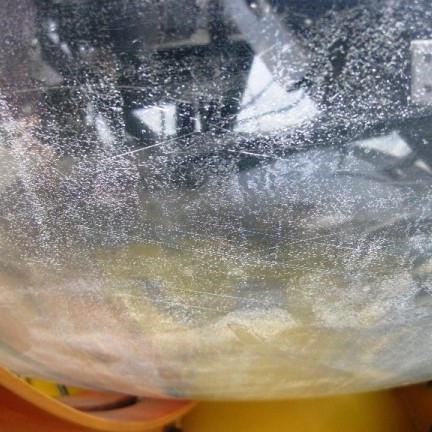Your selection of an acrylic provider will go a long way in determining the ultimate success or failure of your project.
While selecting a good provider can lead to you receiving a fast, high quality solution, selecting the wrong provider can cause a wide variety of headaches including cost overruns, time delays, frequent repairs and more.
When it comes to separating the high quality providers from the rest there are two key areas to look at:
- 1. UV Stability of Acrylic
- 2. Crazing
Don’t worry, we are going to address both in this article so that you are able to make a much more informed decision when selecting an acrylic provider.
1) UV Stability of Acrylic
Acrylic panels cast for use in water-retaining aquarium and other applications should be chemically stabilized to prevent breakdown by ultra violet light rays (UV).
This means a UV absorber should be added the acrylic that acts as a UV filter. The UV stabilizer should be noted for its resistance to both discoloration and loss of light transmittance from UV radiation.
Without the addition of UV absorber the acrylic when exposed to UV radiation (particularly sunlight) will turn yellow and decrease in transparency.
Unless you desire UV transmission, which is sought after in some cases, be sure that your acrylic provider adds a quality UV absorber.
2) Crazing

Crazing refers to the phenomenon where glassy plastics develop what appears to be a multitude of cracks, which initiate at the surface of the material and grow perpendicularly to the direction of stress.
These discontinuities are not always cracks, however, and have been called “crazes” because they resemble, somewhat, the cracks found in glass and ceramics, particularly the glazes on pottery.
Random crazing pattern
Studies have shown that there are at least five factors which may cause glassy plastics to craze:
- Applied or residual tensile stress
- Temperature differential across thickness of acrylic member generating stresses on the surface of acrylic
- Weathering
- Sorption and desorption of moisture generating stresses on the surface of acrylic
- Contact with organic solvents.
The factors which will initiate premature crazing in the acrylic component in service are:
1. Increase in surface stresses above the design stress level by the following factors:
a. Residual stresses introduced by manufacturing process.
b. Thermal gradient through the material created by various service conditions.
c. Residual stresses introduced by improper mounting procedure of the acrylic component.
d. Water concentration gradient near the acrylic surface caused by absorption and desorption of water.
2. Decrease in the inherent critical crazing stress threshold on the acrylic surface by the following factors:
a. Polymer chain scission caused by ultraviolet radiation, x-ray, nuclear radiation, oxidative, and chemical degradation.
b. Plasticization effects caused by absorption of water or an organic solvent.

Crazing
Premature crazing due to the above mentioned factors may appear in as short a time as seconds, or as long a time as years prior to the appearance of crazing predicted solely on the basis of design stress magnitude, duration of loading and design temperature environment.
The greatest effect on acceleration of premature crazing is the plasticization effect of organic solvents, followed by increase in surface stresses and polymer chain scission.
To prevent, or postpone, crazing your acrylic sheet provider should do the following:
1. Optimize the annealing process so that the magnitude of residual stresses on the surfaces of the acrylic item are < 150 psi. Residual stresses higher than 150 psi, but less than 800 psi, are acceptable, but not desirable.
2. Maintain the tensile design stress < 800 psi for continuous loading service (i.e. windows in underwater habitats or aquaria) and < 1200 psi for intermittent loading service (i.e., windows in submarines, hyperbaric chambers, etc.).
3. Avoid contact with fluids, vapors, or gases of organic cleaners or solvents.
4. Maintain the ambient environment at < 100°F.
5. Shade the surfaces from direct sunlight.
6. Avoid sudden local heating of the surfaces to > 160’F.
7. Avoid periodic wetting and drying of the surfaces.
8. Avoid exposure to x-ray radiation.
Once crazing appears, steps should be immediately taken to remove it, as leaving it in place will cause the craze marks to deepen, ultimately being transformed into deep, sharp cracks. While mild crazing (i.e. barely visible) reduces the flexure strength of acrylic only by approximately 40%, severe crazing (i.e., depth of craze 0.01-0.015 in) reduces it by approximately 70%.
This severe reduction in flexure strength is insufficient to initiate catastrophic failure, as acrylic windows designed to ASME PVHO-1 Safety Standard require approximately a 90% reduction in the physical properties of acrylic in a window that originally met the requirements of the ASME PVHO-1 Safety Standard for 125°F (52°C) ambient temperature.

Crazing
One more key thing that providers should do when it comes to crazing is to use acrylic that is resistant to crazing.
The resistance to crazing of acrylic varies from one grade of acrylic material to another. Typically the craze resistance of commercial acrylic material meeting the minimum requirements of ASME PVHO-1 or (Heat-resistant acrylic MIL-P-5425) is the lowest, while that of the stretched cross-linked acrylic (modified heat and crack propagation resistant acrylic MIL-P-25690) are the highest.
At SeaQuatic Aquariums, we use cast acrylic. This ground-breaking acrylic sheet is suited for a variety of applications due to its virtual distortion-free clarity. In fact, it offers the optical quality and light stability of acrylic resin in a crystal clear, lightweight, rigid and weather-resistant thermoplastic sheet. Cast acrylic grades are available that meet ASME PVHO-1 and MIL-P-25690.
Cast acrylic is also resistant to breakage and dimensionally stable. It can be easily machined, sawed, heat-formed and cemented.
The quality of our cast acrylic is so high that it carries an industry-leading 10-year limited warranty on light transmission.
